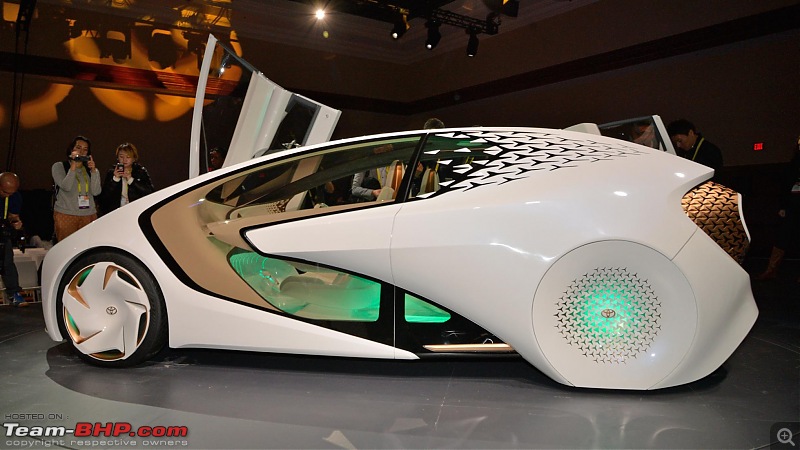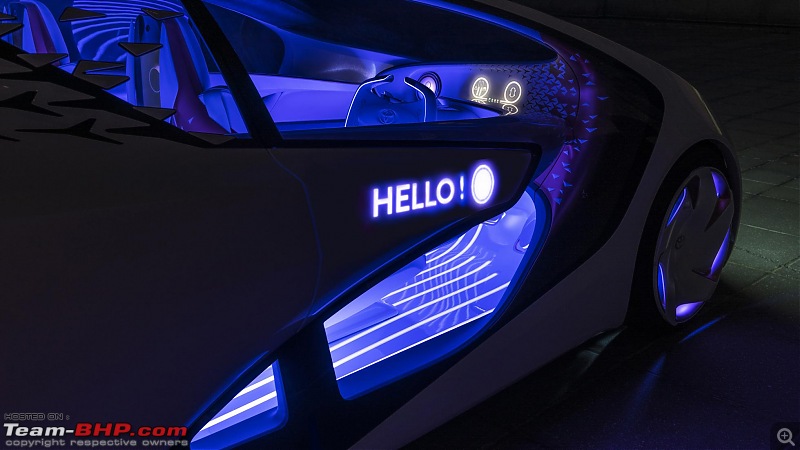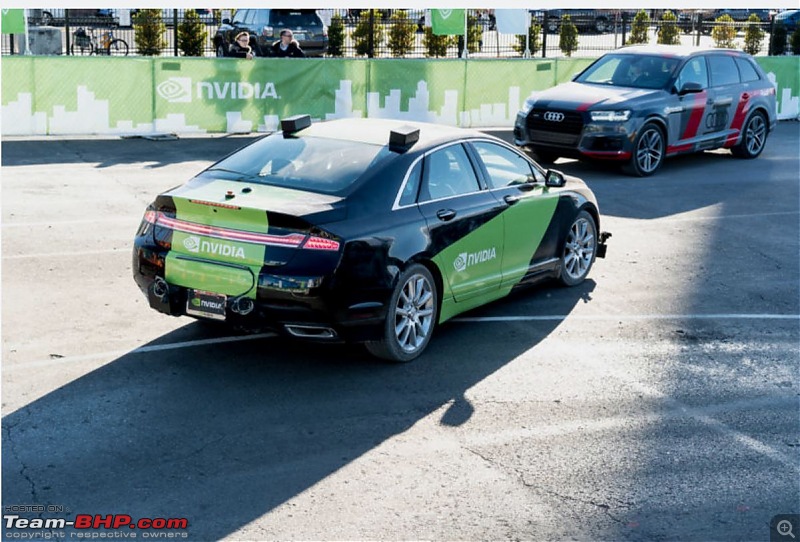| |||||||
 |
| Search this Thread |  13,944 views |
| | #1 |
| BHPian | CES 2017 - An overview "In recent years, CES has started to look more and more like an auto show," Nissan chief executive Carlos Ghosn said in his keynote speech. CES has seen more automakers join the confab in the last few years, and this year was no exception. Automakers and tech companies collaborate on everything from navigation systems and dashboards to more ambitious projects like self-driving cars gadgets. This annual event is now more relevant than ever for car makers and tech firms to show off future developments.  What was talked about, and what went viral!! Faraday future FF91: Construction on its $1 billion factory in North Las Vegas had stalled. Suppliers were suing for unpaid bills. And several investigations, exposed new details about the company’s financial difficulties. Several top executives resigned. In-spite of all these negative reports looming around them, the key highlights at CES 2017 have included the reveal of the first production car from tech start-up Faraday Future. The FF91 has the Tesla models firmly in its sights and is claiming to be the world's fastest production car with a 0-62mph time of only 2.39s.  Huge and beautiful. From the looks of it, the FF91 seems to be a worthy opponent of the Model X.  LiDAR on the hood.  Detailed view of tail light which was teased months before. Nissan: Carlos Ghosn announced several technologies and partnerships as part of the Nissan Intelligent Mobility blueprint for transforming how cars are driven, powered, and integrated into wider society. These technologies will advance mobility toward a zero-emission, zero-fatality future on the roads. As per Mr.Ghosn, the market expert’s main 4 predictions towards automotive future are as below; 1. By 2030, 15% of new vehicles sold could be autonomous - eyes off & hands free. 2. 25 % of new cars sold will be EV in urban areas, compared to less than 1% in 2015. 3. 1/4th mile clocked on roads will be under shared mobility. 4. 2025- All cars will be connected to internet. With the above prediction on mind, Nissan is slated to bring around 10 news EV with autonomous features by 2020. Rather than concentration only on autonomous driving capabilities, Nissan brought forward the concept of “Nissan Intelligent Mobility” and three main pillars are • Intelligent driving. • Intelligent Power. • Intelligent integration. To accelerate the time it will take for autonomous vehicles to get on the road safely, Mr.Ghosn announced a breakthrough technology called "Seamless Autonomous Mobility," or SAM. Developed from NASA technology, SAM partners in-vehicle artificial intelligence (AI) with human support to help autonomous vehicles make decisions in unpredictable situations and build the knowledge of in-vehicle AI. This technology could potentially enable millions of driverless cars to co-exist with human drivers in an accelerated timeline. In addition to advancements in Nissan's autonomous driving strategy, Ghosn also announced plans to launch a new Nissan LEAF, with proPILOT technology, enabling autonomous drive functionality for single-lane highway driving. However, Mr.Ghosn and Nissan’s team at CES 2017 were modest when it came to committing on when we can see completely driverless cars where there is no need for human intervention. He believes there is still a lot of development that needs to happen with the industry partners in the next 5 to 10 years, as so much is dependent on computing power development, chip development and camera/sensing technology. Quite contradictory to what we hear and what the media is hyping, Nissan research director Maarten Sierhuis said this, “Show me an autonomous system without a human in the loop and I’ll show you a system that is useless, the world is simply too complex." Maybe he was referring to India, in terms of driving conditions.  For complete speech please refer - http://nissannews.com/en-US/nissan/u...ality-mobility Honda : It seems the news of just being autonomous is not enough to satisfy the people all around the globe. Honda has gone a step ahead on it, so that an autonomous car can actually work for you, and gain some money out of it. Sounds crazy right!!!  According to Honda, a vehicle is parked a whopping 96 percent of the time. With that in mind, the automaker unveiled the NeuV (New Electric Urban Vehicle) concept, an autonomous automobile that could potentially make its owner some extra cash by acting as its own low-level, Uber-like ride-hailing service. And when the NeuV isn't making its owner money, it's learning about that person through the Honda Automated Network Assistant AI (HANA). But it's doing more than just figuring out when a person is most likely to drive and the best route to their job; it's using what the company calls an "emotion engine" to detect the "emotions behind the driver's judgments." There's no word when or if the NeuV will make it out of concept territory and into showrooms. So we'll wait and hope the HANA AI guilts the automaker into releasing her into the world. BMW: When the new of autonomous driving is flooding the internet these days, BMW has gone slightly in a different path. What would car interiors look like when you no longer need to do the stuffs we do in a car now? BMW has brought a cockpit concept Dubbed the ‘i Inside Future’, the concept focuses on minimalism and features technological advances from the automaker in in-car technology, including a HoloActive Touch system that could replace the current iDrive system. It’s an evolution of BMW’s Gesture Control system that allows you to swoop and swish your hands around instead of physically pressing the buttons. HoloActive Touch will ditch the traditional dashboard in favour of a massive floating display that stretches across the cabin.  A camera detects the hand movements and registers the position of fingertips, in particular. As soon as a fingertip makes contact with one of the virtual menu options, a pulse is emitted and the relevant action is activated. You’ll know you’ve made a selection thanks to feedback from an airborne vibrating pulse. Toyota: Another automaker who went beyond the concept of autonomous driving and tried to compliment the human interactions with the car. With it gull wing doors and outrageous styling, it is a bit of a departure from the safe and basic styling one might associate with the brand.  Like all concept cars, this is intended not to hit the road as-is but to demonstrate the carmaker's vision of the future. The concept i vision involves two things: making the car safer, and changing the way people interact with their vehicles. The virtual companion named Yui, AI partner that acts as part copilot, part travel guide and part spa attendant, all the while getting to know you better over time.  Yui is probably still a long way from real-world launch; Toyota’s own Research Institute has said confidently that self-driving is still a long way off. Questions like how much and when to trigger relaxation in a driver definitely complicate this.  Fiat Chrysler: Visit the Chrysler Portal concept microsite - https://iimediaevents.com/chryslerportalconcept/ Another unique concept which didn’t follow much behind the autonomous driving techs, though it has one. More than just being autonomous, FCA Portal showed how the future cars will offer more utility, flexibility on space and off-course being smart. An all-electric vehicle, the Chrysler Portal concept is propelled by a single electric motor driving the front wheels. A lithium-ion battery pack, rated at around 100 kWh, is estimated to have more than 250 miles of range on a full charge.  The Chrysler Portal concept is capable of SAE Level Three semi-autonomous operation and the driver has the option to turn driving control over to the vehicle under certain highway driving situations.  The vehicle is equipped with an array of sensor technologies (LIDAR/radar/sonar/vision) that constantly monitor conditions outside and inside the vehicle. The Chrysler Portal concept is engineered to upgrade to higher levels of autonomy as technology progresses, and if the owner is interested in adding it to their vehicle.  Daimler: Yet another OEM which didn’t want to bring much fanfare about cars in an electronic show. Maybe they are loading their cannons for this year’s Frankfurt Auto show. Remember AMG hyper car!!! The presence of Mercedes-Benz and smart at the CES was dominated by a new corporate strategy, known as CASE where products and concepts relating to the four strategic pillars "Connected", "Autonomous", "Shared & Service" and "Electric Drive. As far as intelligent additional services are concerned, the company is also presenting its vision of how society's increasing health awareness can be intelligently integrated into ideas for the mobility of the future.  The navigation system on board the Concept EQ is based on the HERE map platform and offers a unique 3D view. The system employs the GPU technology from NVIDIA. The concept vehicle "Fit & Healthy" provides an outlook on how a vehicle can actively promote the well-being of its occupants. "Regeneration" and "Activation" are two of the worlds of experience that can be enjoyed by the user of this concept vehicle, based on a Mercedes-Maybach S Class. These provide physical and mental relaxation or stimulation with the help of numerous comfort systems such as fragrancing, massage, ambient light, ionisation or climate control. The worlds of experience are both cognitive and sensory in many dimensions of perception. "Motion", the third "Fit & Healthy" function in the vehicle, focuses on movement. Audi: Teaming up with Nvidia, Audi aims to bring level-4 autonomous capabilities to their fleet of cars by no later than 2020. Using Nvidia’s artificial intelligence technology, the firms are showcasing the possibilities with a Q7 test car in the car park of CES, which has learned to drive itself in four days.  Nvidia also announced a number of other partnerships, including one with German engineering firm Bosch and Audi, BMW and Daimler-owned mapping company, Here. |
| |  (3)
Thanks (3)
Thanks
 |
| The following 3 BHPians Thank redbaron91 for this useful post: | GTO, Jakku, VijayAnand1 |
| |
| | #2 | |
| BHPian Join Date: May 2009 Location: --
Posts: 897
Thanked: 1,169 Times
| Here's what the automotive future looks like Came across this interesting article in the TOI today. Reading it made me think of the possibilities that could come up. While most of us already consider our cars as our best buddies, but this kind of innovation and technology will only take a level higher. Read on- Quote:
| |
| |  (2)
Thanks (2)
Thanks
 |
| The following 2 BHPians Thank centaur for this useful post: | GTO, redbaron91 |
| | #3 |
| BHPian | Re: CES 2017 - An overview Car companies have recently been telling us what the car of 2020 will be like: autonomous is one word used, electric is another, and it will be connected to the internet too. I believe we are at verge of another industry revolution through Auto industry. One thing I'm sure of, fossil-fueled car will become a thing of the past soon. An electric car (or a fuel cell car) industry is going to take over the world starting next decade. But how far these things will come true and be a part of every mans life? And how long will it take? We, humans fantasied about flying cars since long time, same with faster mode of travel within Earth and many other. Some technologies have slowly trickled down to every human on Earth, but many of them remained as mere fantasies. With advancement of AI, data science & advanced materials, let us hope all these are for sustainable development of our species. |
| |  (1)
Thanks (1)
Thanks
 |
| The following BHPian Thanks redbaron91 for this useful post: | GTO |
 |

